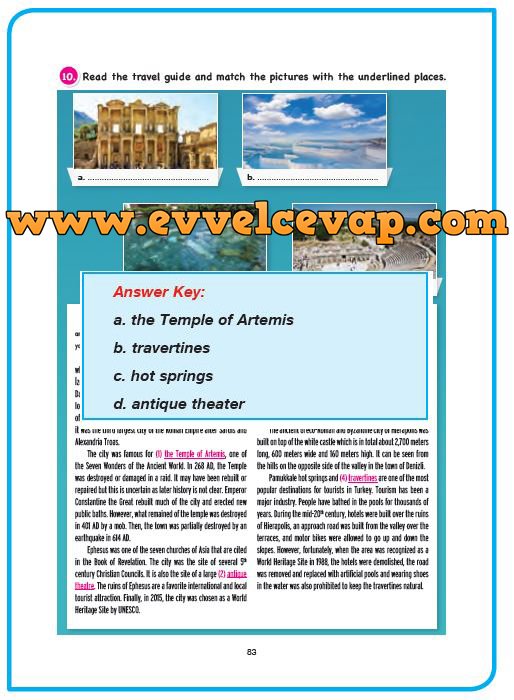11. Sınıf Cem Yayınları İngilizce Ders Kitabı Sayfa 83 Cevabı 2017 – 2018 Yeni Müfredat
11. Sınıf Cem Yayınları İngilizce Ders Kitabı Sayfa 83 Cevabı
Read the travel guide and match the pictures with the underlined places.
If you are interested in visiting historic sites, or seeing one of the Seven Wonders of the Ancient World or World Heritage sites, you are in the correct place: The Aegean Coast of beautiful Turkey! There are a couple of alternatives of course, but this brochure will inform you about the history of Ephesus and Pamukkale. Don’t miss the boat, come and see Turkey this summer!
• Ephesus was an ancient Greek city on the coast of lonia, which was three kilometers southwest of present-day Selçuk, in İzmir province, Turkey. Ephesus was built in the 10th century BC. During the Classical Greek era, it was one of the twelve cities of the Ionian League. The city flourished after it came under the control of the Roman Republic in 129 BC. According to the archeologists, it was the third largest city of the Roman Empire after Sardis and Alexandria Troas.
The city was famous for (1) the Temple of Artemis, one of the Seven Wonders of the Ancient World. In 268 AD, the Temple was destroyed or damaged in a raid. It may have been rebuilt or repaired but this is uncertain as later history is not clear. Emperor Constantine the Great rebuilt much of the city and erected new public baths. However, what remained of the temple was destroyed in 401 AD by a mob. Then, the town was partially destroyed by an earthquake in 614 AD.
Ephesus was one of the seven churches of Asia that are cited in the Book of Revelation. The city was the site of several 5th century Christian Councils. It is also the site of a large (2) antigue theatre. The ruins of Ephesus are a favorite international and local tourist attraction. Finally, in 2015, the city was chosen as a World Heritage Site by UNESCO.
• Pamukkale, which was also called Hierapolis, is a natural site in Denizli, a province in southwestern Turkey. The city contains (3) hot springs and travertines, which are terraces of carbonate minerals left by the flowing water. It is located in Turkey’s Inner Aegean region, in the River Menderes valley, which has a temperate climate for most of the year.
The ancient Greco-Roman and Byzantine city of Hierapolis was built on top of the white castle which is in total about 2,700 meters long, 600 meters wide and 160 meters high. It can be seen from the hills on the opposite side of the valley in the town of Denizli.
Pamukkale hot springs and (4) travertines are one of the most popular destinations for tourists in Turkey. Tourism has been a major industry. People have bathed in the pools for thousands of years. During the mid-20th century, hotels were built over the ruins of Hierapolis, an approach road was built from the valley over the terraces, and motor bikes were allowed to go up and down the slopes. However, fortunately, when the area was recognized as a World Heritage Site in 1988, the hotels were demolished, the road was removed and replaced with artificial pools and wearing shoes in the water was also prohibited to keep the travertines natural.
- Cevap:





















